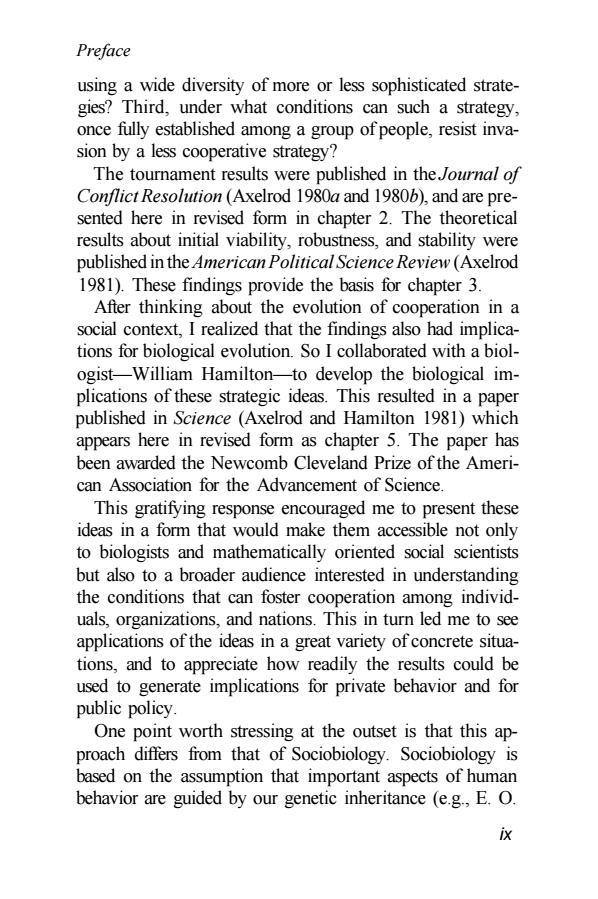正在加载图片...

Preface using a wide diversity of more or less sophisticated strate- gies?Third,under what conditions can such a strategy, once fully established among a group of people,resist inva- sion by a less cooperative strategy? The tournament results were published in the Journal of Conflict Resolution(Axelrod 1980a and 1980b),and are pre- sented here in revised form in chapter 2.The theoretical results about initial viability,robustness,and stability were published in the American Political Science Review (Axelrod 1981).These findings provide the basis for chapter 3. After thinking about the evolution of cooperation in a social context,I realized that the findings also had implica- tions for biological evolution.So I collaborated with a biol- ogist-William Hamilton-to develop the biological im- plications of these strategic ideas.This resulted in a paper published in Science (Axelrod and Hamilton 1981)which appears here in revised form as chapter 5.The paper has been awarded the Newcomb Cleveland Prize of the Ameri- can Association for the Advancement of Science. This gratifying response encouraged me to present these ideas in a form that would make them accessible not only to biologists and mathematically oriented social scientists but also to a broader audience interested in understanding the conditions that can foster cooperation among individ- uals,organizations,and nations.This in turn led me to see applications of the ideas in a great variety of concrete situa- tions,and to appreciate how readily the results could be used to generate implications for private behavior and for public policy. One point worth stressing at the outset is that this ap- proach differs from that of Sociobiology.Sociobiology is based on the assumption that important aspects of human behavior are guided by our genetic inheritance (e.g.,E.O. ⅸPreface using a wide diversity of more or less sophisticated strategies? Third, under what conditions can such a strategy, once fully established among a group of people, resist invasion by a less cooperative strategy? The tournament results were published in the Journal of Conflict Resolution (Axelrod 1980a and 1980b), and are presented here in revised form in chapter 2. The theoretical results about initial viability, robustness, and stability were published in the American Political Science Review (Axelrod 1981). These findings provide the basis for chapter 3. After thinking about the evolution of cooperation in a social context, I realized that the findings also had implications for biological evolution. So I collaborated with a biologist—William Hamilton—to develop the biological implications of these strategic ideas. This resulted in a paper published in Science (Axelrod and Hamilton 1981) which appears here in revised form as chapter 5. The paper has been awarded the Newcomb Cleveland Prize of the American Association for the Advancement of Science. This gratifying response encouraged me to present these ideas in a form that would make them accessible not only to biologists and mathematically oriented social scientists but also to a broader audience interested in understanding the conditions that can foster cooperation among individuals, organizations, and nations. This in turn led me to see applications of the ideas in a great variety of concrete situations, and to appreciate how readily the results could be used to generate implications for private behavior and for public policy. One point worth stressing at the outset is that this approach differs from that of Sociobiology. Sociobiology is based on the assumption that important aspects of human behavior are guided by our genetic inheritance (e.g., E. O. ix